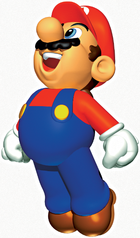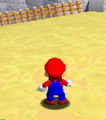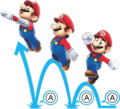Double Jump (consecutive)

The Double Jump (alternatively stylized as double jump), also called the Continuous Jump,[1] is a move introduced in Super Mario 64. It is usable by every player character in the Super Mario series ever since its debut, except for Super Mario 3D Land, Super Mario 3D World, Super Mario Run, Super Mario 3D World + Bowser's Fury, and Super Mario Bros. Wonder. The purpose of the Double Jump is for the player character to gain a higher altitude. The player can have their character perform a Double Jump by pressing the jump button just after landing from a prior jump. The resulting Double Jump moves the character slightly higher than a standard jump. After the player character lands from a Double Jump, quickly pressing the jump button for a third time executes a Triple Jump. Double Jumps are one of the few jumps that a player character can use while standing still. However, in New Super Mario Bros. and its sequels, the player character has to be running at full speed in order to double-jump.
Gallery[edit]
Mario performing a Double Jump in Super Mario 64, after a normal jump and before a Triple Jump
Artwork of Mario performing a jump, Double Jump, and Triple Jump from Super Mario Galaxy
See also[edit]
Names in other languages[edit]
| Language | Name | Meaning | Notes |
|---|---|---|---|
| Japanese | ダブルジャンプ[?] Daburu Janpu |
Double Jump | |
| Chinese (simplified) | 连续跳[2] Liánxù Tiào |
Continuous Jump | |
| Chinese (traditional) | 2級跳[3] 2 Jí Tiào |
Double Jump | |
| Dutch | Dubbelsprong[?] | Double jump | |
| French | Double saut[4] | Double jump | |
| German | Doppelsprung[?] | Double jump | |
| Italian | Salto continuo[5] | Continuous jump | |
| Doppio salto[6][7] | Double jump | ||
| Salto consecutivo[8][9] | Consecutive jump | ||
| Salto doppio[10][11] | Double jump | ||
| Salto in due tempi[?] | Jump in two times | Super Mario Bros. Wonder | |
| Korean | 2단 점프[?] 2(i)dan Jeompeu |
Double Jump | |
| Portuguese (NOA) | Pulo Contínuo[12] | Continuous Jump | |
| Portuguese (NOE) | Salto Duplo[?] | Double jump | |
| Russian | Двойной прыжок[?] Dvoynoy pryzhok |
Double jump | |
| Spanish | Salto Doble[?] | Double Jump |
References[edit]
- ^ 1996. Super Mario 64 instruction booklet. Nintendo of America (English). Page 10.
- ^ 神游马力欧DS的动作. iQue (Simplified Chinese). Retrieved March 6, 2020.
- ^ 新 超級瑪利歐兄弟 Wii - 香港任天堂網站. Nintendo of HK (Traditional Chinese). Archived June 18, 2010, 14:44:56 UTC from the original via Wayback Machine. Retrieved August 6, 2024.
- ^ 1997. Super Mario 64 instruction booklet (PDF). French. Page 50.
- ^ 1997. Super Mario 64 instruction manual. Nintendo of Europe (French). Page 31.
- ^ 2006. New Super Mario Bros. instruction manual. Nintendo of Europe (Italian). Page 90.
- ^ 2012. New Super Mario Bros. Wii European manual. Nintendo of Europe (Italian). Page 17.
- ^ 2007. Super Mario Galaxy instruction manual. Nintendo of Europe (Italian). Page 15.
- ^ 2010. Super Mario Galaxy 2 Italian manual. Nintendo of Europe (Italian). Page 17.
- ^ 2012. New Super Mario Bros. 2 Italian e-manual. Nintendo (Italian). Page 7.
- ^ 2012. New Super Mario Bros. U Italian e-manual. Nintendo (Italian). Page 15.
- ^ Super Mario 64 Brazilian instruction booklet. Page 10.

